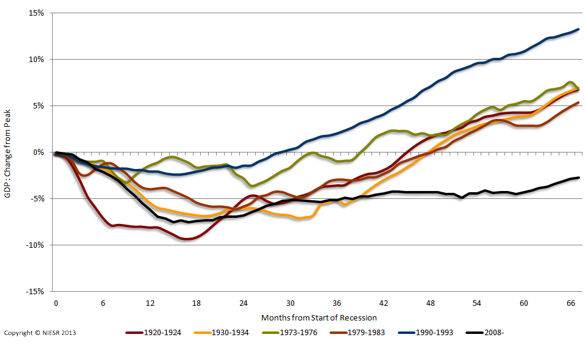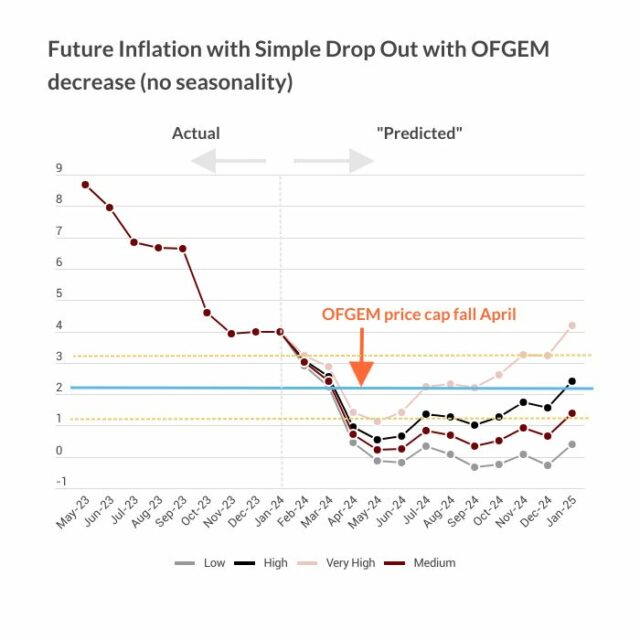Our monthly estimates of GDP suggest that output grew by 0.9 per cent in the three months ending in August after growth of 0.7 per cent in the three months ending in July 2013. This recent rate of growth is the fastest since the three months ending in July 2010 (also 0.9 per cent). Our estimates suggest the level of GDP is now 2.7 per cent lower than the peak of January 2008. Looking ahead, the rate of growth will likely soften, somewhat, over coming quarters. The external environment in the guise of weak demand from the Euro Area and slowing emerging markets will likely limit the rate of the UK’s economic expansion.
Figure 1. The profile of recession and recovery

Notes: Calculated from centred three-month moving averages of monthly GDP, the effect of the miners’ strike in 1921 is excluded from the 1920-1924 profile (the strike started on 31st March 1921 and ended on 28th June 1921).
The National Institute interprets the term “recession” to mean a period when output is falling or receding, while “depression” is a period when output is depressed below its previous peak. Thus, unless output turns down again, the recession is over, while the period of depression is likely to continue for some time. We do not expect output to pass its peak in early 2008 until 2015.
Our track record in producing early estimates of GDP suggests that our projection for the most recent three-month period has a root mean squared error (RMSE) of 0.238% point (for the full sample period 1999Q3-2012Q4) when compared to the first estimate produced by the ONS. For the period 2008Q1 to 2012Q4 the RMSE is 0.360% point. The impact of the adverse weather in 2010Q4 is a noticeable outlier. Excluding 2010Q4 from the analysis, the RMSE for the full sample period is 0.198% point, and for 2008Q1 to 2012Q4 the RMSE is 0.274% point. These comparisons can be made only for complete calendar quarters. Outside calendar quarters the figures are less reliable than this and they are also likely to be less accurate in the current disturbed economic circumstances.
A paper describing the methodology used to produce the data was published in the February 2005 volume of the Economic Journal:
Mitchell, J. Smith, R. J., Weale, M. R., Wright, S. and Salazar, E. L. (2005) ‘An Indicator of Monthly GDP and an Early Estimate of Quarterly GDP Growth’, Economic Journal, No. 551, pp. F108-F129.
Available from: http://onlinelibrary.wiley.com/journal/10.1111/(ISSN)1468-0297
A paper describing the methodology used to produce the data for the inter-war period was published in the October 2012 volume of Explorations in Economic History:
Mitchell, J., Solomou, S. and Weale, M. (2012) ‘Monthly GDP estimates for inter-war Britain’, Explorations in Economic History, Vol. 49, No. 4, pp. 543-556.
Available from: http://www.journals.elsevier.com/explorations-in-economic-history/
From April until October 2006 our estimates were computed using the Index of Services published by ONS. However this monthly series shows considerable volatility which has caused us some problems in estimating GDP. From our November 2006 press release we have therefore reverted to using a model of private services output based on indicator variables. This means that, while all our figures for calendar quarters are fully coherent with ONS data, our estimates of monthly private service output are not. The series can be thought of as indicating the underlying value of the ONS series.
For more information please telephone Simon Kirby (NIESR, Centre for Macroeconomics) on 020 7654 1916.
 Pub. Date
Pub. Date
 Pub. Type
Pub. Type






















